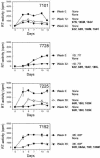Diminished replicative fitness of primary human immunodeficiency virus type 1 isolates harboring the K65R mutation
- PMID: 15750116
- PMCID: PMC1081293
- DOI: 10.1128/JCM.43.3.1395-1400.2005
Diminished replicative fitness of primary human immunodeficiency virus type 1 isolates harboring the K65R mutation
Abstract
The human immunodeficiency virus type 1 (HIV-1) reverse transcriptase (RT) resistance mutation K65R confers intermediate levels of resistance to several RT inhibitors, including a three- to fourfold reduction of tenofovir susceptibility. Here, we have used for the first time primary HIV-1 isolates from individuals who developed the K65R mutation while enrolled in a clinical trial of tenofovir to analyze the impact of this mutation on HIV-1 replicative fitness. A marked impairment in replicative fitness was observed in association with the selection of viruses carrying the K65R mutation in all patients. The mean replicative fitness among these viruses was 20% relative to the corresponding baseline wild-type virus, ranging from 10 to 32% depending on the accompanying RT mutations. These results support a reduction in in vivo replication for K65R mutant viruses.
Figures


References
-
- Bloor, S., S. D. Kemp, K. Hertogs, T. Alcorn, and B. A. Larder. 2000. Patterns of HIV drug resistance in routine clinical practice: a survey of almost 12,000 samples from the USA in 1999. Antivir. Ther. 5:169.
-
- Cornelissen, M., R. van den Burg, F. Zorgdrager, V. Lukashov, and J. Goudsmit. 1997. pol gene diversity of five human immunodeficiency virus type 1 subtypes: evidence for naturally occurring mutations that contribute to drug resistance, limited recombination patterns, and common ancestry for subtypes B and D. J. Virol. 71:6348-6358. - PMC - PubMed
-
- Deeks, S. G. 2001. Durable HIV treatment benefit despite low-level viremia: reassessing definitions of success or failure. JAMA 286:224-226. - PubMed
-
- Deval, J., K. L. White, M. D. Miller, N. T. Parkin, J. Courcambeck, P. Halfon, B. Selmi, J. Boretto, and B. Canard. 2004. Mechanistic basis for reduced viral and enzymatic fitness of HIV-1 reverse transcriptase containing both K65R and M184V mutations. J. Biol. Chem. 279:509-516. - PubMed
-
- Gallant, J. E., P. Z. Gerondelis, M. A. Wainberg, N. S. Shulman, R. H. Haubrich, M. St. Clair, E. R. Lanier, N. S. Hellmann, and D. D. Richman. 2003. Nucleoside and nucleotide analogue reverse transcriptase inhibitors: a clinical review of antiretroviral resistance. Antivir. Ther. 8:489-506. - PubMed
Publication types
MeSH terms
Substances
Associated data
- Actions
- Actions
- Actions
- Actions
- Actions
- Actions
- Actions
- Actions
- Actions
- Actions
Grants and funding
LinkOut - more resources
Full Text Sources
Molecular Biology Databases

